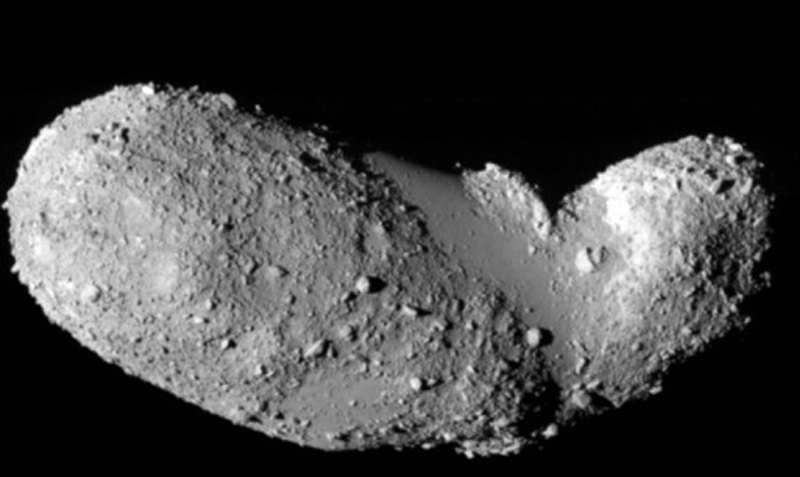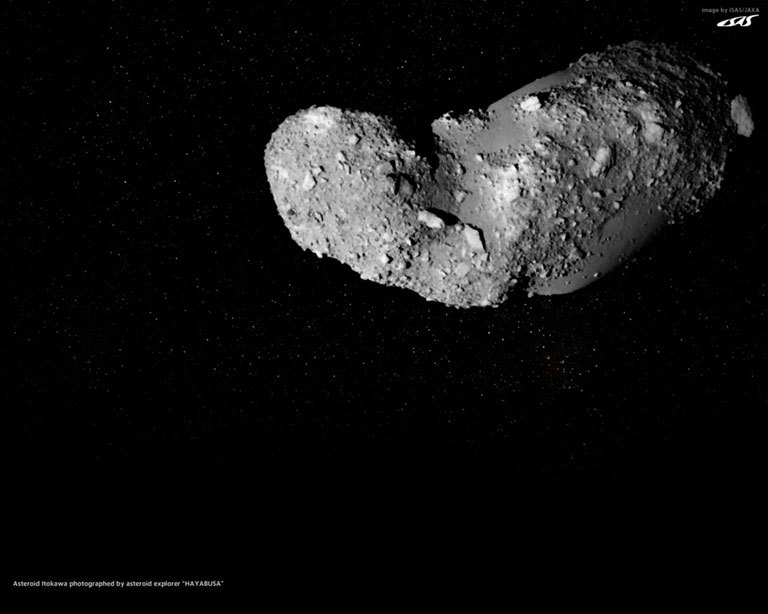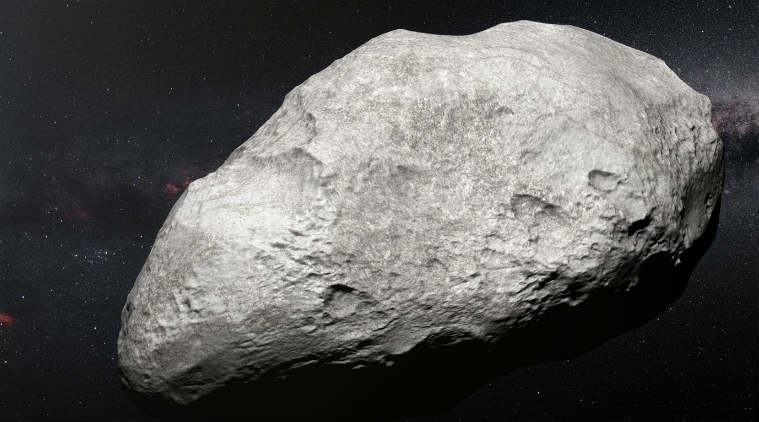
The vast majority, however, are much smaller and are irregularly shaped; they are thought to be either surviving planetesimals or fragments of larger bodies. Vesta is the only main-belt asteroid that can, on occasion, be visible to the naked eye. On some rare occasions, a near-Earth asteroid may briefly become visible without technical aid; see Apophis.
Asteroid Itokawa in the news – Sabian Earth I
The mass of all the objects of the asteroid belt , lying between the orbits of Mars and Jupiter , is estimated to be about 2. The number of asteroids then increases rapidly as their individual masses decrease. The number of asteroids decreases markedly with size. Although their location in the asteroid belt excludes them from planet status, the three largest objects, Ceres , Vesta , and Pallas , are intact protoplanets that share many characteristics common to planets, and are atypical compared to the majority of "potato"-shaped asteroids.
The fourth largest asteroid, Hygiea , has an undifferentiated interior, like the majority of asteroids. Between them, the four largest asteroids constitute half the mass of the asteroid belt. Ceres is the only asteroid with a fully ellipsoidal shape and hence the only one that is a dwarf planet. Vesta, too, has a differentiated interior, though it formed inside the Solar System's frost line , and so is devoid of water; [45] [46] its composition is mainly of basaltic rock such as olivine.
Pallas is unusual in that, like Uranus , it rotates on its side, with its axis of rotation tilted at high angles to its orbital plane. Hygiea is the largest carbonaceous asteroid [50] and, unlike the other largest asteroids, lies relatively close to the plane of the ecliptic. Measurements of the rotation rates of large asteroids in the asteroid belt show that there is an upper limit. No asteroid with a diameter larger than meters has a rotation period smaller than 2.
For asteroids rotating faster than approximately this rate, the inertial force at the surface is greater than the gravitational force, so any loose surface material would be flung out. However, a solid object should be able to rotate much more rapidly. This suggests that most asteroids with a diameter over meters are rubble piles formed through accumulation of debris after collisions between asteroids. The physical composition of asteroids is varied and in most cases poorly understood. Ceres appears to be composed of a rocky core covered by an icy mantle, where Vesta is thought to have a nickel-iron core, olivine mantle, and basaltic crust.
- Water found in samples from asteroid Itokawa.
- Navigation menu.
- Hayabusa2 comes home: remarkable space probe could open another window into how life originated.
- aries february 1 2021 weekly horoscope by marie moore.
Most of the smaller asteroids are thought to be piles of rubble held together loosely by gravity, though the largest are probably solid. Some asteroids have moons or are co-orbiting binaries : Rubble piles, moons, binaries, and scattered asteroid families are thought to be the results of collisions that disrupted a parent asteroid, or, possibly, a planet. Asteroids contain traces of amino acids and other organic compounds, and some speculate that asteroid impacts may have seeded the early Earth with the chemicals necessary to initiate life, or may have even brought life itself to Earth also see panspermia.
Composition is calculated from three primary sources: albedo , surface spectrum, and density. The last can only be determined accurately by observing the orbits of moons the asteroid might have. So far, every asteroid with moons has turned out to be a rubble pile, a loose conglomeration of rock and metal that may be half empty space by volume.

Only half a dozen asteroids are larger than 87 Sylvia , though none of them have moons; however, some smaller asteroids are thought to be more massive, suggesting they may not have been disrupted, and indeed Davida , the same size as Sylvia to within measurement error, is estimated to be two and a half times as massive, though this is highly uncertain. The fact that such large asteroids as Sylvia can be rubble piles, presumably due to disruptive impacts, has important consequences for the formation of the Solar System: Computer simulations of collisions involving solid bodies show them destroying each other as often as merging, but colliding rubble piles are more likely to merge.
This means that the cores of the planets could have formed relatively quickly. The surface of the asteroid appears completely covered in ice. As this ice layer is sublimated , it may be getting replenished by a reservoir of ice under the surface. Organic compounds were also detected on the surface. The presence of ice on 24 Themis supports this theory. In October , water was detected on an extrasolar body for the first time, on an asteroid orbiting the white dwarf GD According to one of the scientists, "The lines are becoming more and more blurred between comets and asteroids.
Most asteroids outside the " big four " Ceres, Pallas, Vesta, and Hygiea are likely to be broadly similar in appearance, if irregular in shape. Of the big four, Pallas and Hygiea are practically unknown. Vesta has compression fractures encircling a radius-size crater at its south pole but is otherwise a spheroid. Ceres seems quite different in the glimpses Hubble has provided, with surface features that are unlikely to be due to simple craters and impact basins, but details will be expanded with the Dawn spacecraft , which entered Ceres orbit on 6 March Asteroids become darker and redder with age due to space weathering.
Asteroids are commonly classified according to two criteria: the characteristics of their orbits, and features of their reflectance spectrum.
Explained: What is Japan’s Hayabusa2 mission?
Many asteroids have been placed in groups and families based on their orbital characteristics. Apart from the broadest divisions, it is customary to name a group of asteroids after the first member of that group to be discovered. Groups are relatively loose dynamical associations, whereas families are tighter and result from the catastrophic break-up of a large parent asteroid sometime in the past. A family has also been associated with the plutoid dwarf planet Haumea.
More From TOI
Some asteroids have unusual horseshoe orbits that are co-orbital with Earth or some other planet. Examples are Cruithne and AA The first instance of this type of orbital arrangement was discovered between Saturn 's moons Epimetheus and Janus. Sometimes these horseshoe objects temporarily become quasi-satellites for a few decades or a few hundred years, before returning to their earlier status. Both Earth and Venus are known to have quasi-satellites. Such objects, if associated with Earth or Venus or even hypothetically Mercury , are a special class of Aten asteroids.
However, such objects could be associated with outer planets as well. In , an asteroid taxonomic system based on color , albedo , and spectral shape was developed by Clark R.
Chapman , David Morrison , and Ben Zellner. This classification has since been expanded to include many other asteroid types. The number of types continues to grow as more asteroids are studied. The former was proposed in by David J. Tholen , and was based on data collected from an eight-color asteroid survey performed in the s. This resulted in 14 asteroid categories. Both systems have three broad categories of C, S, and X asteroids, where X consists of mostly metallic asteroids, such as the M-type. There are also several smaller classes.
The proportion of known asteroids falling into the various spectral types does not necessarily reflect the proportion of all asteroids that are of that type; some types are easier to detect than others, biasing the totals. Originally, spectral designations were based on inferences of an asteroid's composition. This has led to significant confusion. Although asteroids of different spectral classifications are likely to be composed of different materials, there are no assurances that asteroids within the same taxonomic class are composed of similar materials.
A newly discovered asteroid is given a provisional designation such as AT 4 consisting of the year of discovery and an alphanumeric code indicating the half-month of discovery and the sequence within that half-month. Once an asteroid's orbit has been confirmed, it is given a number, and later may also be given a name e.
The formal naming convention uses parentheses around the number e. Informally, it is common to drop the number altogether, or to drop it after the first mention when a name is repeated in running text. The first asteroids to be discovered were assigned iconic symbols like the ones traditionally used to designate the planets.
By there were two dozen asteroid symbols, which often occurred in multiple variants. He introduced a disk circle , a traditional symbol for a star, as the generic symbol for an asteroid. The numbered-circle convention was quickly adopted by astronomers, and the next asteroid to be discovered 16 Psyche , in was the first to be designated in that way at the time of its discovery. However, Psyche was given an iconic symbol as well, as were a few other asteroids discovered over the next few years see chart above. The circle was soon abbreviated to a pair of parentheses, which were easier to typeset and sometimes omitted altogether over the next few decades, leading to the modern convention.
Until the age of space travel , objects in the asteroid belt were merely pinpricks of light in even the largest telescopes and their shapes and terrain remained a mystery.
R29 Original Series
The best modern ground-based telescopes and the Earth-orbiting Hubble Space Telescope can resolve a small amount of detail on the surfaces of the largest asteroids, but even these mostly remain little more than fuzzy blobs. Limited information about the shapes and compositions of asteroids can be inferred from their light curves their variation in brightness as they rotate and their spectral properties, and asteroid sizes can be estimated by timing the lengths of star occulations when an asteroid passes directly in front of a star.
Radar imaging can yield good information about asteroid shapes and orbital and rotational parameters, especially for near-Earth asteroids. In terms of delta-v and propellant requirements, NEOs are more easily accessible than the Moon. The first close-up photographs of asteroid-like objects were taken in , when the Mariner 9 probe imaged Phobos and Deimos , the two small moons of Mars , which are probably captured asteroids. These images revealed the irregular, potato-like shapes of most asteroids, as did later images from the Voyager probes of the small moons of the gas giants.
The first true asteroid to be photographed in close-up was Gaspra in , followed in by Ida and its moon Dactyl , all of which were imaged by the Galileo probe en route to Jupiter. The first dedicated asteroid probe was NEAR Shoemaker , which photographed Mathilde in , before entering into orbit around Eros , finally landing on its surface in Other asteroids briefly visited by spacecraft en route to other destinations include Braille by Deep Space 1 in , and Annefrank by Stardust in In September , the Japanese Hayabusa probe started studying Itokawa in detail and was plagued with difficulties, but returned samples of its surface to Earth on 13 June On 13 December , China's lunar orbiter Chang'e 2 flew within 3.
In early , NASA announced the planning stages of a mission to capture a near-Earth asteroid and move it into lunar orbit where it could possibly be visited by astronauts and later impacted into the Moon.
- cancer 3 february horoscope.
- Asteroid 25143 Itokawa in the news.
- Astrology Ephemeris | Centaur Ephemeris | Asteroid Ephemeris | TNO.
It has been suggested that asteroids might be used as a source of materials that may be rare or exhausted on Earth asteroid mining , or materials for constructing space habitats see Colonization of the asteroids. Materials that are heavy and expensive to launch from Earth may someday be mined from asteroids and used for space manufacturing and construction. In the U. Discovery program the Psyche spacecraft proposal to 16 Psyche and Lucy spacecraft to Jupiter trojans made it to the semifinalist stage of mission selection.
Asteroids and the asteroid belt are a staple of science fiction stories. Asteroids play several potential roles in science fiction: as places human beings might colonize, resources for extracting minerals, hazards encountered by spacecraft traveling between two other points, and as a threat to life on Earth or other inhabited planets, dwarf planets and natural satellites by potential impact.
Vesta imaged by Dawn on 9 July Ceres imaged by Dawn on 4 February There is a list of all authors in Wikipedia. Login Email Address.
Sign In. Remember Me. Forgot Password? Top Links. Social Share. For other uses, see Asteroid disambiguation. This section does not cite any sources. Please help improve this section by adding citations to reliable sources. Unsourced material may be challenged and removed.
 Itokawa asteroid astrology
Itokawa asteroid astrology
 Itokawa asteroid astrology
Itokawa asteroid astrology
 Itokawa asteroid astrology
Itokawa asteroid astrology
 Itokawa asteroid astrology
Itokawa asteroid astrology
 Itokawa asteroid astrology
Itokawa asteroid astrology
Related itokawa asteroid astrology
Copyright 2020 - All Right Reserved